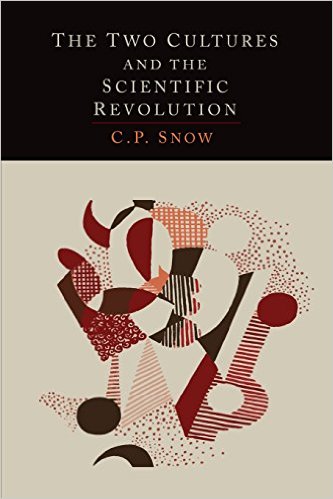Book Review: The Two Cultures and the Scientific Revolution
The Two Cultures and the Scientific Revolution
by C. P. Snow
Review by Kristin Visser
The Two Cultures and the Scientific Revolution by C. P. Snow, an English physical chemist and novelist, is based on the Rede Lecture, which he gave at Cambridge University in 1959. His short yet astonishingly forward-thinking text has recently been reprinted and continues to speak into the gulf between the culture of science and the culture of the arts. Snow argued that practitioners in both areas should learn how to communicate with one another and build bridges to further the progress of human knowledge and to benefit society.
The book begins with a lengthy introduction that explains Snow’s upbringing and education—he studied science in school, served in several important positions in the British Civil Service, and turned to writing later in life. His experience with both cultures—of science and the arts—enabled him to recognize that while both cultures are intelligent and have much to contribute to society, they did not communicate with each other.
“A good many times I have been present at gatherings of people who, by the standards of the traditional culture, are thought highly educated and who have with considerable gusto been expressing their incredulity at the illiteracy of scientists. Once or twice I have been provoked and have asked the company how many of them could describe the Second Law of Thermodynamics. The response was cold; it was also negative. Yet I was asking something which is about the scientific equivalent of, “Have you read a work of Shakespeare’s?”
Snow goes on to compare the educational systems of the United States, the Soviet Union, and England, noting that while the divide between the two cultures of the sciences and the humanities was present in each country, it was most distinct—in 1963—in England because students had to specialize in one academic area much earlier in their schooling. He argues that the quality of education is on the decline and addresses the widening gap between rich and poor brought about by the Industrial Revolution which left many countries behind.
While England is the focus of Snow’s writing, he successfully depicts how the distinction between the two cultures of science and the arts is present in other parts of the world as well. His comparisons paint a picture of key issues facing society in 1959: namely the need for increased communication between scientists and non-scientists, the need for more science education, and the responsibility of the developed countries to play a role in bringing the Industrial Revolution to developing countries.
The book closes with Snow taking a second look at The Two Cultures and the Scientific Revolution four years after his original lecture was given. He responds to both the positive and negative feedback caused by his lecture—which was printed and translated into many different languages—and concludes that his analysis of the “two cultures” was not an original idea, but rather a topic which many had already been thinking and talking about.
Snow’s lecture not only provides support for liberal arts education, but urges the educated person to use knowledge to help the developing world. This fits well within a Christian worldview. And while his lecture addresses the way things were in 1959, much of what he says nearly sixty years ago is still—or is even more—applicable today!

